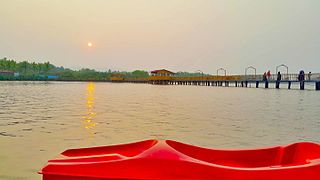
Kannur is one of the 14 districts along the west coast in the state of Kerala, India. The city of Kannur is the district headquarters and gives the district its name. The old name, Cannanore, is the anglicized form of the Malayalam name "Kannur". Kannur district is bounded by Kasaragod District to the north, Kozhikode district to the south, Mahé district to the southwest and Wayanad District to the southeast. To the east, the district is bounded by the Western Ghats, which forms the border with the state of Karnataka. The Arabian Sea lies to the west. Paithalmala is the highest point in Kannur District (1,372m). Enclosed within the southern part of the district is the Mahé district of the Union Territory of Puducherry. The district was established in 1957.
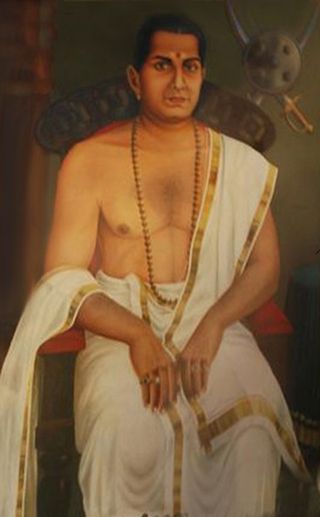
Kerala Varma Pazhassi Raja, also known as Cotiote Rajah and Pychy Rajah, was the de facto head of the Kottayam Kingdom in the Malabar region of Kerala between 1774 and 1805. His struggles with the British East India Company is known as the Cotiote War. Pazhassi's rebellion against the British is often touted as one of the earliest acts of freedom fight in India. He earned the epithet "Kerala Simham" on account of his martial exploits.

Ayillyath Kuttiari Gopalan, popularly known as A. K. Gopalan or AKG, was an Indian communist politician. He was one of 16 Communist Party of India members elected to the first Lok Sabha in 1952. Later he became one of the founding members of the Communist Party of India (Marxist).

Thalassery, formerly Tellicherry, is a municipality and commercial city on the Malabar Coast in Kannur district in the state of Kerala, India, bordered by the districts of Mahe, Kozhikode, Wayanad, Kasaragod and Kodagu (Karnataka). Thalassery municipality has a population of just under 100,000 as of 2011 census. Thalassery Heritage City has an area of 23.98 square kilometres (9.26 sq mi). Thalassery has an altitude ranging from 2.5 to 30 metres above mean sea-level.
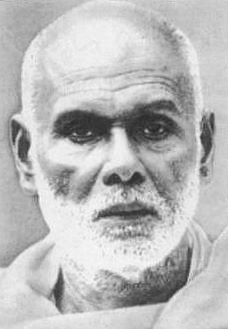
Karatt Govinda Menon, better known as Brahmananda Swami Sivayogi, was an Indian sanyasi from present-day Kerala who founded the Ananda Maha Sabha in 1918. He proposed Anandadarsam or Anandamadham.
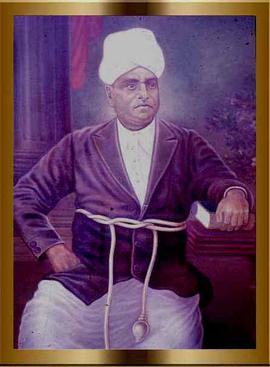
Oyyarathu Chandu Menon was a Malayalam language novelist. He is the author of Indulekha, the first major novel in Malayalam published in 1889.

The Madras Regiment is the oldest infantry regiment of the Indian Army, originating in the 1750s as a unit of the British East India Company. The regiment took part in numerous campaigns with the British Indian Army and the post-independence Indian Army. The Madras Regiment primarily recruits from the erstwhile Madras state and the kingdom of Mysore. However, the 9th and 16th battalions were later formed from troops from the kingdoms of Travancore and Cochin in present day Kerala.

Malabar District, also known as British Malabar or simply Malabar was an administrative district on the southwestern Malabar Coast of Bombay Presidency (1792–1800), Madras Presidency (1800–1937), Madras Province (1937–1950) and finally, Madras State (1950–1956) in India. It was the most populous and the third-largest district in the erstwhile Madras State. The historic town of Kozhikode was the administrative headquarters of this district.

Chekavar were the warriors belonging to Hindu Thiyya community in Malabar of Kerala. Many Thiyya families today trace their roots to this Chekavar lineage.

The Ezhavas, also known as Thiyya or Tiyyar in the Malabar region, are a community with origins in the region of India presently known as Kerala, where in the 2010s they constituted about 23% of the population and were reported to be the largest Hindu community. The Malabar Ezhava group has claimed a higher rank in the Hindu caste system than the other Ezhava groups but was considered to be of a similar rank by colonial and subsequent administrations.
Thandan is the honorary surname given to the headman of the mainly Thiyya caste people in Palakkad, Thrissur district, who reside in the Indian state of Kerala. They are designated as an Other Backward Class by the Government of Kerala.
Vayaleri kunhikannan Gurukkal-(Vagbhatananda) was a Hindu religious leader and Reform movement in British India. He was the founder of the Atmavidya Sangham, which was fundamentally a group of professionals and intellectuals who sought change, and also the Uralungal Labour Contract Co-Operative Society.
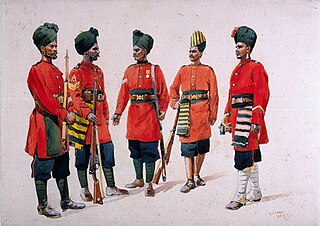
The Nizam's Contingent, later Hyderabad Contingent, was a British-officered army of the Nizam of Hyderabad.

Kannur, formerly known in English as Cannanore, Arabic as Kannanur, and Portuguese as Cananor, is a city and a Municipal Corporation in North Malabar region, state of Kerala, India. It is the largest city in North Malabar, which is the northernmost region of Kerala. It is sometimes identified Kolathunadu, which was ruled by the Kolathiris. In the 12th and 13th centuries there was trade with Persia and Arabia.
Thalassery was a trade hub where Chinese, Arab, and Jewish traders had considerable influence in the spice market; before that the Greeks and Romans were in the trade. It was the European invasion that brought significant change as they enforced the trade with their military.

Rao Sahib Ayyathan Gopalan, popularly known as Darsarji and Darsar Sahib, was an Indian doctor, surgeon, professor, writer, philanthropist, social reformer, and Renaissance leader from Kerala. He is the founder of the Sugunavardhini movement (1900) and Depressed classes mission (1909) and also the leader and propagandist of Brahmo Samaj (1893) in Kerala. He denounced idol worship and fought to end those social practices in Kerala that he thought were unethical. Among his followers were Brahmananda Swami Sivayogi, Vaghbatananda, and Brahmavadhi P. Kunhiraman. Gopalan titled P. Kunhiraman as "Brahmavadhi" and Sivayogi as "Brahmananda Swami".

Dr. Ayyathan Janaki Ammal (1878–1945) was the first female doctor in Kerala during British rule in India. She was also the first female doctor from the Thiyya community and also hailed with the title as the first Malayali lady doctor and surgeon. and the sister to Ayyathan Gopalan. a social reformer of Kerala, the founder of the Sugunavardhini movement (1900), Depressed Classes Mission (1909) and the leader and propagandist of Brahmo Samaj in Kerala.

The Kallingal Madathil Rarichan Moopan (1856–1919) was a Jenmi in Kozhikode. He was a social reformer of Malabar. He is known for community development and other social services.
The Kontoth assault names a clash in 1930 over temple entry. Lower castes were not allowed to walk in front of the kondoth-temple of the Thiyya castes at Kondoth in Kannur. A.K. Gopalan led a procession to grieve the Harijans and the Thiyyar Leaders and the Thiyyar women who witnessed the brutal beating of A.K.G. and the Harijans.



!['tlshsheeri reekhk[?] (Thalassery Manuscripts)' on Thiyyar Pattalam(Thiyyar Army) of 1799 formed by British, a predecessor of Thiyyar regiment 39A8599.pdf cropped.png](http://upload.wikimedia.org/wikipedia/commons/thumb/2/2d/39A8599.pdf_cropped.png/220px-39A8599.pdf_cropped.png)














